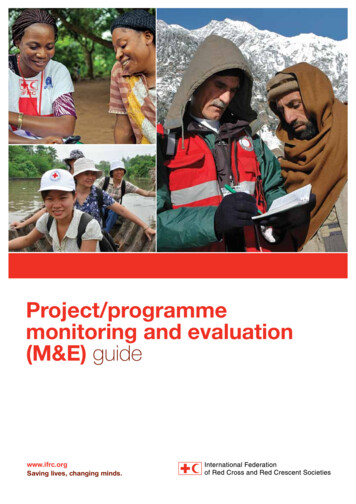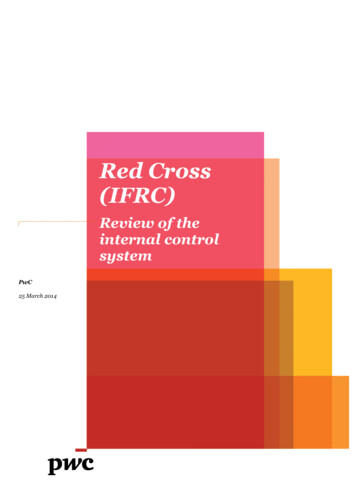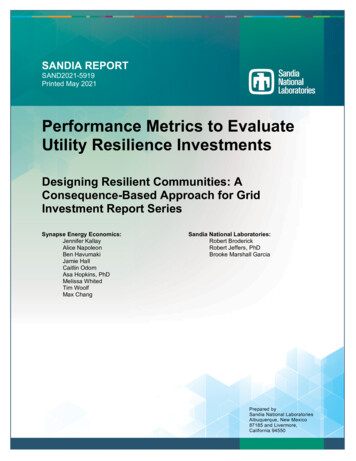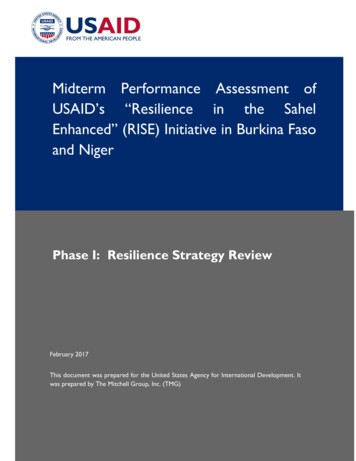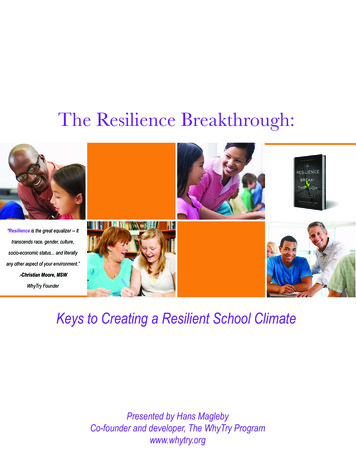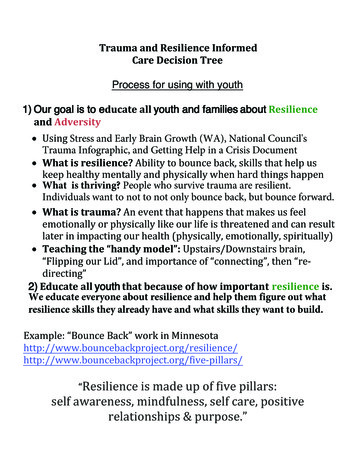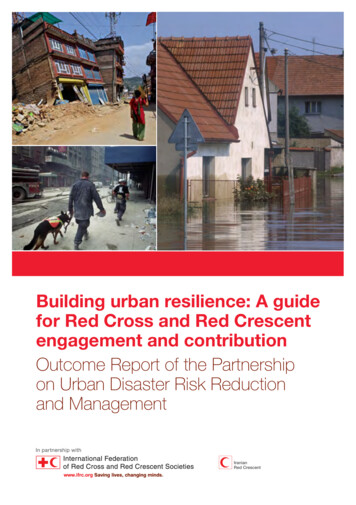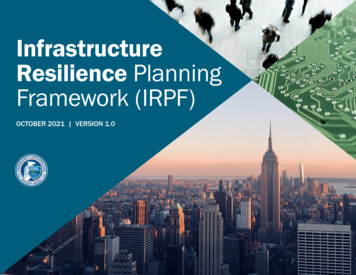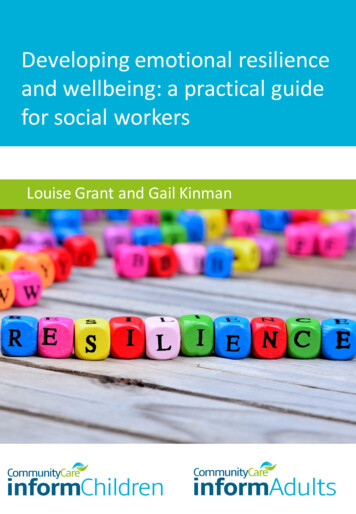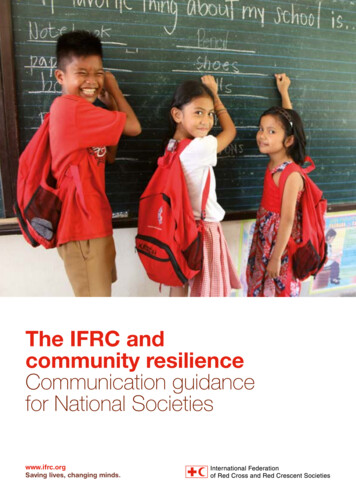
Transcription
1The IFRC andcommunity resilienceCommunication guidancefor National Societieswww.ifrc.orgSaving lives, changing minds.
2The International Federation of Red Cross and Red CrescentSocieties (IFRC) is the world’s largest volunteer-basedhumanitarian network. With our 190 member National RedCross and Red Crescent Societies worldwide, we are in everycommunity reaching 160.7 million people annually throughlong-term services and development programmes, as well as110 million people through disaster response and early recoveryprogrammes. We act before, during and after disasters andhealth emergencies to meet the needs and improve the lives ofvulnerable people. We do so with impartiality as to nationality,race, gender, religious beliefs, class and political opinions.Guided by Strategy 2020 – our collective plan of action to tacklethe major humanitarian and development challenges of thisdecade – we are committed to saving lives and changing minds.Our strength lies in our volunteer network, our communitybased expertise and our independence and neutrality. We workto improve humanitarian standards, as partners in development,and in response to disasters. We persuade decision-makers toact at all times in the interests of vulnerable people. The result:we enable healthy and safe communities, reduce vulnerabilities,strengthen resilience and foster a culture of peace around theworld. International Federation of Red Crossand Red Crescent Societies, Geneva, 2016Any part of this publication may be cited, copied,translated into other languages or adapted to meetlocal needs without prior permission from theInternational Federation of Red Cross and Red CrescentSocieties, provided that the source is clearly stated.Requests for commercial reproduction should bedirected to the IFRC Secretariat at secretariat@ifrc.orgAll photos used in this study are copyright of theIFRC unless otherwise indicated.Cover photo: Cover photo by Niki Clark,American Red Cross, March 2015Even though it was damaged by high winds and fallen trees,Tanghas Elementary School in Leyte, Philippines, shelteredsome 20 families after Typhoon Haiyan. In partnership withthe Spanish Red Cross, The American Red Cross providedfunds to install hand water pumps, construct six newlatrines, and repair classrooms. Approximately 130 studentsattend the school. Its five teachers all survived and returnedto teach there. The children received backpacks full ofsupplies to start the new school year. The project contributedto education, water and sanitation, disaster risk reductionand community resilience.P.O. Box 303CH-1211 Geneva 19SwitzerlandTelephone: 41 22 730 4222Telefax: 41 22 733 0395E-mail: secretariat@ifrc.orgWeb site: www.ifrc.orgThe IFRC and community resilience-Communicationguidance for National Societies1310400 11/2016 EFollow us:
International Federation of Red Cross and Red Crescent Societies3The IFRC and community resilience Communication guidance for National SocietiesContentsIntroduction41. Purpose42. Community resilience: what do we mean?43. Our approach and contribution54. An enabling environment11Key messages17Annex – Community resilience: our history20
International Federation of Red Cross and Red Crescent Societies4The IFRC and community resilience Communication guidance for National SocietiesIntroduction1. PurposeThe International Federation of Red Crossand Red Crescent Societies (IFRC) has developed this paper to support Red Crossand Red Crescent staff and volunteers intheir communication and advocacy oncommunity resilience. The paper explainsthe IFRC’s definition of and approach tobuilding community resilience, sets outkey messages, and suggests how to communicate the rationale for promotingcommunity resilience to a broad audience.The document draws on the IFRC’s Framework for Community1 Resilience and thestrategy behind the One Billion Coalitionfor Resilience2.The messages and evidence in this papershould inform discussions, plans anddecision-making in national disaster riskreduction or disaster management platforms, policy forums, community consultations, and project design.2. Community resilience:what do we mean?Resilience1 nce-EN-LR.pdf2 ition/The concept of resilience is rooted in thephysical sciences. By extension, resiliencerefers to the ability of people and systems,including ecological and social systems, toadapt successfully to change. Resilienceis required, and the capacity to be resilient exists, at many levels: in individuals,households, and communities, in localand national government, within organizations, as well as nationally, regionallyand globally. National Society can contribute to resilience at all these levels.The IFRC defines resilience as ‘the abilityof individuals, communities, organizationsor countries exposed to disasters, crises andunderlying vulnerabilities to anticipate, prepare for, reduce the impact of, cope with andrecover from the effects of shocks andstresses without compromising their longterm prospects’.CommunityThe IFRC’s Framework for CommunityResilience defines a community as ‘a groupof people who may or may not live within thesame area, village or neighbourhood, share asimilar culture, habits and resources’. Communities are groups of people exposed tothe same threats and risks, for examplesuch as disease, political and economicdangers, or natural disasters. Resilience isrelevant worldwide, because all countrieshave communities that are vulnerable.The IFRC believes that resilient communities are the foundation of resilient nations.Its focus on communities enables the IFRCto benefit from National Societies’ longand deep experience of supporting localcommunities.HolisticA holistic approach means looking at thecontext in which communities live as awhole, not seeing them through the lensof a single sector. Communities are complexand dynamic and so are the challengesthat they confront. Many different factors(including physical, human, financial,natural and social) can affect resilience,and they interconnect. Solutions musttherefore be holistic and multi-sectoral.Strengthening community resilience meanslooking at how different factors affect eachanother, and the community, and at whata National Society can do to assist communities to reduce their vulnerability andstrengthen their capacity.Why now?In the past decade, humanitarian need hasgrown at a staggering rate. The number of
International Federation of Red Cross and Red Crescent Societies5The IFRC and community resilience Communication guidance for National Societiespeople who rely on humanitarian assistancehas more than tripled while the cost of responding has increased five-fold3. Everythingsuggests that this growth will continue.The humanitarian sector’s response cannot be more of the same, because it will notbe possible to mobilize enough resources tomeet the growing demands and complexity of unanticipated events and enduringhumanitarian crises. We need to take alonger view and to make more effectiveuse of our collective resources to reduceneed. To do this, communities must bebetter prepared for the risks they face.It is also time to redefine success. Successwithin the humanitarian sector should nolonger be defined in terms of the increasing number of people we reach, but in termsof the decreasing number of people whoneed us to reach them. The objective offuture humanitarian action should be topreserve human dignity by helping peopleto anticipate, prepare for, respond to andrecover from shocks and stresses in theirlives and communities, so that they canthrive even in adversity. The case for resilience has grown over the past 20 years. Alarge body of evidence, reflecting economic, political, humanitarian and moral perspectives, confirms its importance.The world of humanitarian action is nowat a tipping point. New partnerships andfunding are creating the conditions fora paradigm shift. Evidence shows thatbuilding resilience saves both money andlives by reducing the financial, administrative and resource costs of respondingto crises. Through unprecedented collaboration and wise investment, we can reduce costs and need, and achieve a moreresilient world in which fewer lives aredisrupted or ended by disaster, conflictand disease.3. Our approachand contributionOur commitmentsIn a declaration adopted at the IFRC General Assembly in 2013, the IFRC made threecommitments with regard to the post-2015humanitarian agenda. It undertook to: Enable every community in high-riskareas to acquire the capacity to preparefor and respond to disasters. Have a volunteer in every community inwhich we work who is responsible for facilitating access to basic health services. Continue efforts to strengthen NationalRed Cross and Red Crescent Societies astrusted partners and effective auxiliariesto their governments in humanitarianand development work.As part of its efforts to pursue communityresilience, IFRC convened the One BillionCoalition for Resilience (1BC), an unprecedented commitment by individuals, communities, organizations, businesses andgovernments to transform the state ofresilience in the world. 1BC is a vehicle forrealizing the potential of our collectivenetworks to share resources and to effectchange on a massive scale. It is an opportunity to drive a paradigm shift in humanitarian response, in which the measure of success is not the number of people we reach,but the number of people who do not needour support. The vision of the 1BC is a worldwhere people are safer, healthier and canthrive, even in adversity. To realize this vision, the goal of the 1BC is to mobilize onebillion people to take action to strengthencommunity resilience, everywhere.We recognize and acknowledge the manycurrent and recent efforts that seek to establish or reinforce global policy frameworksto improve the humanitarian state of the3 ources/WHDT2015 2Dec.pdf
International Federation of Red Cross and Red Crescent Societies IFRCThe IFRC and community resilience Communication guidance for National Societies6
International Federation of Red Cross and Red Crescent SocietiesThe IFRC and community resilience Communication guidance for National Societiesworld. From disaster risk reduction (Sendai,March 2015), via sustainable development(New York, September 2015), climate change(Paris, December 2015), and urban development (Quito, October 2016), to the High-Level Panel on Humanitarian Financing (November 2015), the Global Response to HealthCrises (December 2015) and the World Humanitarian Summit (May 2016), the IFRCand 1BC have engaged in and contributed toa dialogue that emphasizes resilience.The IFRC’s approachThe IFRC’s Framework for Community Resilience (FCR) provides the rationale for allrelevant activities (interventions, projects,programmes, etc.) at community level,while the One Billion Coalition for Resilience (1BC) provides the platform for action. National Societies contribute to 1BCby rolling out the framework and scalingup their work for community resilience.The FRC sets out the IFRC’s approach tocommunity resilience. Its three elementsare presented below.71) Assist communities as they adopt riskinformed, holistic approaches to addresstheir underlying vulnerabilitiesTaking a risk-informed approach meansassessing past, present and future risksthat confront a community, and then integrating prevention, mitigation, preparedness, response and recovery into plans,decisions, and action. If this approach istaken, emergency planning is less likely tobe driven by shocks than by vulnerability,and development planning is less likely tobe blind to disaster risk or climate change.Strengthening community resilience is aprocess led and owned by communities. Itis not something that National Societiescan do for them, or bring to them. The design and implementation of programmesto strengthen community resilience shouldbe people-led by community members,not service-led by any organization. People and communities always have capacities. The IFRC’s role is to help boost these.What do communities want?The people most likely to know how things around them work and how to improvetheir lives live in the communities in which National Societies work. To understandwhat resilience means for some of them, the IFRC studied community experiences during the 2004 Indian Ocean tsunami, and in Latin America and theCaribbean. Summarizing what community members said, these studies4 foundthat a resilient community:1. Is knowledgeable, healthy and can meet its basic needs.2. Is socially cohesive.3. Has economic opportunities.4. Has well-maintained and accessible infrastructure and services.5. Can manage its natural assets.6. Is connected.IFRC continues to develop its understanding of what communities want in differentregions and how lessons from one community can be used and replicated inothers. Tracking the outcomes and evaluating the impact of programmes byNational Societies and IFRC is therefore vital. The features of a resilient community identified so far represent general characteristics. However, the FCRassumes they can be applied in most communities.4 IFRC, Understanding communityresilience and program factors thatstrengthen them, A comprehensivestudy of Red Cross and RedCrescent Societies’ tsunamioperation (2012).At: http://www.ifrc.org/PageFiles/96984/Final SynthesisCharacteristics Lessons Tsunami.pdf
International Federation of Red Cross and Red Crescent Societies8The IFRC and community resilience Communication guidance for National SocietiesCommunity-based health and community resilience in IrelandThe Irish Red Cross aims to strengthen community resilience byhelping communities to be as healthy as possible. Ireland was thefirst country to introduce a community-based health and first aid inaction programme in prisons. A partnership between the Irish PrisonService, the Irish Red Cross and the City of Dublin Education andTraining Board led to a pilot project in 2009. Today the programmeoperates in all 14 prisons across the country.Photo from Mountjoy Prison, Dublin, Ireland,FREE-IT Lifelong Learning Project,May 2014Prisoners are the community in a prison; the volunteers are prisonerstoo. Groups attend weekly community-based health and first aidtraining sessions and undertake Red Cross volunteer training. Morethan 700 special status Irish Red Cross volunteers have been recruitedin prisons since 2009 and the project directly benefits more than4,000 prisoners every day.Activities are identified during community assessment using a community-based health and first aid toolkit.The IFRC’s Vulnerability and Capacity Assessment (VCA) toolkit helps identify potential dividers, such as religion,and connecters, such as sport.Volunteers advocate on health issues, produce posters, and conduct surveys to monitor impact. As a result ofthe project, assaults have fallen, HIV testing has increased, mental health has improved, and first aiders havemade more emergency interventions. These outcomes indicate that empowered volunteers have developedhealth care skills that strengthen the resilience of the prison community. The programme has won a numberof awards, including one from the World Health Organization. (For further information and videos see the IrishRed Cross web site. At: www.redcross.ie/cbhfa.)The FCR recognizes that every community and context is dynamic, complexand unique. This means that there are noready-made solutions. The approach inany community must be individually tailored. It must also be monitored and evaluated to ensure that lessons are capturedand applied.Whether a National Society can contributeto the process of strengthening resiliencein a community depends on:1. The vulnerabilities and capacities ofthe community.2. Its links and interaction with the externalenvironment.3. The value that a National Society canadd.The IFRC believes that strengthening community resilience cannot be achieved byone individual, department, organizationor government alone. It believes that genuine resilience programming is holistic andmulti-sectoral. A diverse coalition is required to understand and influence complex systems, even when the response is toa specific threat, such as a flood, a drought,or sexual and gender-based violence.National Societies can contribute supportin a variety of ways. They can: Convene a coalition of stakeholders witha common interest in building resilience. Assess context, vulnerability to specificthreats, and capacity. Organize volunteer networks, throughRed Cross and Red Crescent branches,to reach out to communities.
International Federation of Red Cross and Red Crescent SocietiesThe IFRC and community resilience Communication guidance for National Societies Provide solutions that are: threat-specific but sensitive to larger, more holistic systems; appropriate; technicallysound; effective and efficient; and sensitive to issues such as gender equality, cultural diversity, climate change,and the prevention of violence. Facilitate self-help solutions that mobilize a community’s own resources. Improve a community’s access to external support networks (government,the country offices of United Nationsand other international agencies, civilsociety organizations) as well as to theInternational Red Cross and Red Crescent Movement. Involve communities in risk assessment, monitoring and evaluation. Enhance accountability to communities, government and other partnersby providing regular reports, feedback,gender and diversity analysis, and information about programmes, services and activities.2) Adopt a demand-driven, people-centredapproachOur approach puts people first. It is demandnot supply-driven. The FCR recognizesthat strengthening community resiliencemeans putting people in the driving seat.The IFRC enables individuals and communities to access what they need to improvetheir own lives rather than supply themwith a generic package of resilience goodsand services.Our approach aims to make sure that people remain at the centre of decisions andactions that affect their future. Communities are dynamic; their priorities and leaders change. Programmes that strengthenresilience must also be flexible and adaptas differing priorities emerge within communities. Programmes must continue torespond to the objectives of people and totheir concerns, reflecting changes withintheir community. Examples of actions thatNational Societies might take include:Ensure community programmes areinformed by assessments of needs andcapacity. Assess the vulnerability and capacity ofcommunities. Prioritize needs that communities havechosen to address. Monitor and evaluate programme implementation.Support community members to ownprocesses that strengthen their resilience. Involve community members in designing and implementing community resilience programmes. Assist community organization andownership. Support communities to strengthen theircapacity.Work with Red Cross and Red Crescentvolunteers in their own communities. Engage with communities through localRed Cross and Red Crescent branches. Recognize the potential of volunteersand local branches to act as agents ofchange in the communities in whichthey live or are based.Strengthen both formal and informalsystems that foster an enabling environment for community resilience. Support the development of formal systems (laws, codes, standards etc.) that,for example, strengthen disaster riskreduction or increase community representation in decision-making. Make use of informal systems (traditional customs, indigenous knowledge,etc.) to, for example, deliver climate andweather information.Amplify community voices. Collect testimonies and case studiesthat illustrate how policies and decisions affect the vulnerability of families,households, schools, etc. Share testimonies with public authorities. Raise community perspectives in government committees and decision-makingfora.9
International Federation of Red Cross and Red Crescent Societies10The IFRC and community resilience Communication guidance for National SocietiesCommunity decisions and technical innovation in ColombiaThe Colombian Red Cross prioritizes the development of resilient communities. The people it serves face inequality and poverty, are at risk from disaster and climate change, and have experienced decades of armed conflict.Chocó is the poorest administrative region in Colombia and has the highest rainfall anywhere in the world.In 2010-2011 rain was almost constant, affecting more than 350,000 people. Most people living in Chocóbelong to the country’s Afro- Colombian minority.With funding from ECHO and local government, the Colombian Red Cross - supported by the NetherlandsRed Cross and the Norwegian Red Cross - began a 15-month programme to address disaster preparednessand meet immediate shelter needs. The project provided a range of disaster risk reduction activities in fivecommunities. For the community at San José de la Calle, one option was to move to the nearest town. Theirvillage on the banks of the Atrato river could only be reached by river. The village was cut off when the riverflooded, and people were unable to access schools and livelihoods. But though life was hard, the communityhad land rights there, and chose to stay despite the threat.The project built 80 new houses and a new communal walkway, a school, a community centre, a playgroundand a garden. Village lumberjacks cut local timber and villagers provided labour. The project adopted techniques tested in a neighbouring region to raise all structures on stilts. Skilled carpenters provided training tolocal craftspeople, helping to ensure that technical knowledge would remain in the community when the projectended. Members of the community now live 2.5 metres above river level. (For more information, see 2.html.)Raised house and communal walkway,San José de la Calle, Chocó, Colombia;Photo: Sandra D’Urzo, IFRC
International Federation of Red Cross and Red Crescent SocietiesThe IFRC and community resilience Communication guidance for National Societies Convene meetings that bring togetherpublic authorities and vulnerable populations. Conduct seminars and briefings for public authorities that bring information,data, testimonies and the experiencecollected by vulnerable populations toofficial attention.3) Connecting communities: being available to everyone, everywhere, to preventand reduce human sufferingThe IFRC has 190 member National Societies, 60,000 local branches, and 17 million volunteers worldwide. The strengthof National Societies lies in their abilityto respond to local needs, their role asan auxiliary of national government, andtheir participation in a global federation.Their experience and their strong connection with local communities are central toIFRC’s capacity to strengthen communityresilience. They are the source of IFRC’sexpertise and comparative advantage.National Societies take many forms of action to connect with their communities.For example, they may: Make sure that an inclusive approachis adopted at all levels, that welcomes,respects and values contributions by allmembers of society. Branches can mobilize local volunteers, including affectedpeople, youth, women and girls, marginalized groups, etc. Local volunteers canbe invited or appointed to sit on governance bodies. Partner with the community, civil society and public authorities. The uniquerole of National Societies as an auxiliaryof government is of particular value inthis context. Make use of different methods of communication (online, SMS, radio, newsletters, posters, branch and volunteermeetings, etc.) to connect with communities and community members in waysthat are appropriate and accessible.The 1BC aims to strengthen connectednessbetween partners. Through it, the IFRC, National Societies and other members of thecoalition can interconnect, support kickstart initiatives, and break down obstaclesto resilience using five tools:1. A digital ecosystem for public engagement connects individuals, organizations,experts and governments to one another and to 1BC tools. It helps them tocollaborate and take action, both to assess threats to resilience and design local solutions that strengthen resilience.2. A business continuity platform provides a suite of tools and services forsmall and medium sized enterprises.They help to shorten the time enterprises need to recover from shocks,forge more resilient supply chains, promote stronger links with governmentand communities, and increase insurance cover against potential losses.3. A civil society organizations’ partnership platform assists 1BC partners toconnect and share information witheach other and communities by increasing visibility, transparency, accountability and capacity. It promotesmore effective local partnerships byproviding insights into local networksand community structures that cansupport efforts to build resilience.4. An advocacy platform enhances thecapacity of communities and partnersto speak with one voice, increasingtheir ability to influence decision-makersand opinion leaders, and create or improve government policies, legislationor practices that promote resilience.5. An operations platform brings togetherall the connections and learning ofcoalition members to map local risks,design local solutions, and implementcommunity initiatives that address therisks that communities prioritize.11
International Federation of Red Cross and Red Crescent Societies Myanmar Red Cross SocietyThe IFRC and community resilience Communication guidance for National Societies12
International Federation of Red Cross and Red Crescent Societies13The IFRC and community resilience Communication guidance for National Societies4. An enabling environmentIs it enough?The IFRC’s understanding of communityresilience has grown. The FCR providesguidance on how the IFRC and NationalSocieties can combine their humanitarianconcern to address specific and imminentthreats with longer-term, sustainable approaches traditionally associated withdevelopment. But is this enough?The enabling environment that communityresilience needs is created by:1. The commitment and engagement ofcommunities.2. Coordination and partnerships – thepower of coalitions.3. Finance.4. Legal frameworks and policies.The IFRC plays a significant role in strengthening these enabling factors through itscommunications, advocacy and humanitarian diplomacy.Communication for community resilience in IndonesiaWest Sumatra is extremely vulnerableto natural hazards. In 2009, the IFRCcontributed humanitarian assistanceand coordination after two majorearthquakes struck the region within48 hours, triggering landslides anddestroying at least four villages.The region lies on the geological fault line that caused the Asiantsunami of 2004; earthquakes are a constant threat. The Indonesian Red Cross (PMI) helps communities to reduce their risksand increase their resilience. With support from the French RedCross and Netherlands Red Cross, PMI initiated a programmeon disaster risk reduction that targeted three communities inWest Sumatra. Volunteers held focus group discussions to establish how different sections of the community communicateand what media they use.Disaster risk reduction messages were shared in many differentways, via stickers, posters, television, radio and social media.Partnering with small shopkeepers and food stall owners encouraged the latter to display disaster risk reduction messages ontheir blinds and menus. At the centre of the campaign was afigure drawn by a local artist, representing a traditional characterwhose wisdom is respected by everyone in West Sumatra. PMIvolunteers interviewed members of the community to monitorhow effective disaster risk reduction campaign messages andmedia were and how well people remembered them. In 2011the programme was expanded to include nine communities inthree districts. (See www.preventionweb.net/go/36358.)
International Federation of Red Cross and Red Crescent Societies14The IFRC and community resilience Communication guidance for National SocietiesCommunity commitment and engagementSecuring the engagement and commitmentof communities is the key to strengtheningresilience and sustaining development. Thisimplies that everyone should be involved,including people from marginalized and excluded groups, who are of particular concernto the IFRC and whose voices must be heardwhen building community resilience. Potentially marginalized groups may include: Women and girls. Older people. People living with HIV. People with disabilities. Children and young people. People who have been trafficked ordisplaced. Refugees, displaced people and othermigrants. People of a particular sexual orientation. Members of particular races, groups, castesor classes. Members of indigenous groups. Persons subject to harmful culturalpractices. Other persons deprived of their humanrights.Communities are not targets, but they arethe starting point of efforts to strengthenresilience. Capacity exists in every community, regardless of how poor it is: thiscapacity can be mobilized and organizedby National Societies. The role of womenshould be strengthened, whether they aremembers of the community or membersof Red Cross and Red Crescent teams andgovernance bodies, and evidence of thisstrengthening demonstrated. Building thecapacity of local branches and units is vital because they form an integral part ofthe community and its civil society, enriching the social fabric of both.The commitment to an oldercommunity in SingaporeThe Community-Led Action for Resilience (CLARE) programme,which started in January 2015, is part of the Singapore RedCross contribution to commu
The International Federation of Red Cross and Red Crescent Societies (IFRC) is the world's largest volunteer-based humanitarian network. With our 190 member National Red Cross and Red Crescent Societies worldwide, we are in every community reaching 160.7 million people annually through long-term services and development programmes, as well as

